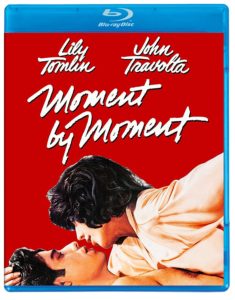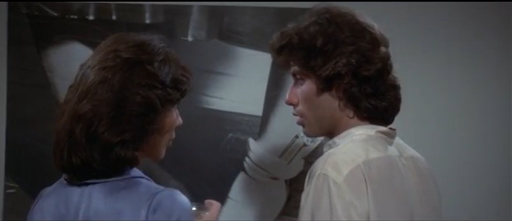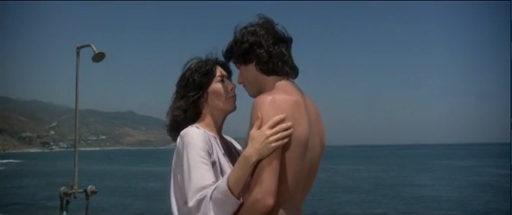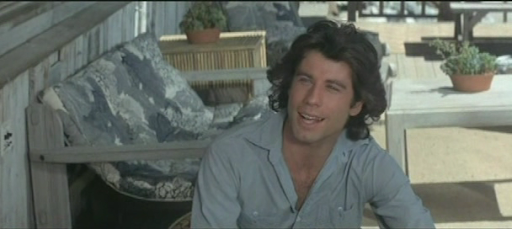1970’s Travolta and Tomlin “Travesty” Unearthed in High Definition.
DIRECTED BY JANE WAGNER/1978
BLU-RAY STREET DATE: AUGUST 24, 2021/KL STUDIO CLASSICS

In the late 1970s, super-producer Robert Stigwood signed rising TV star John Travolta to a three-picture deal. Two of those films were the zeitgeist-rocking musicals Saturday Night Fever (1977) and Grease (summer, 1978), which quickly elevated Travolta to the level of super-famous superstar.
Then came the third and final film of the contract, the romantic drama Moment by Moment. Rolled out by Universal Studios as its major release of the 1978 holiday season, the film quickly acquired a reputation as one of the worst movies ever made. Despite not being a shambles at the box office, the notion of a non-dancing Travolta was apparently simply too much for audiences to accept.
Perhaps more to the point, the nature of the Moment by Moment’s romance was too much. In the film, Travolta plays a drifting beach bum called “Strip” Harrison (who lives up to his first name a couple of times as he doffs his clothes down to a speedo) who falls deeply in love with wealthy divorcée Trisha Rawlings, played by the older Lily Tomlin.
Tomlin is actually the top-billed star of this distinct two-hander, already long established as a wildly successful comedian. Her crossover to the big screen was spurred on by Robert Altman, who, following a part in his classic ensemble Nashville (1975), produced her first film as a lead, Robert Benton’s The Late Show (1977). Moment by Moment was the next one, seemingly ready-made and served piping hot, particularly for a 35+ female demographic. And therein lay the rub. The “women’s picture”, a popular genre unto itself through the 1940s, had long since gone dormant in the increasingly male-driven U.S. movie marketplace. Even with two of the biggest stars in pop culture playing kissy face on screen, filmgoers and critics ultimately could not abide this sort of thing.

The story is a simple one- undeniably decompressed, even at times too simple. But it’s also purely a character drama, the story of two disparate people connecting. Eventually, they fall in love, though, quite authentically, it’s never an easy relationship.
Strip is a lonely puppy-dog of a guy who, for the first twenty minutes of the film, pesters the faint acquaintance Trisha to justifiably restraining-order levels. She occupies her luxurious California beach house all alone as she quietly tries in vain to get her life back on track. Strip offers her illicit sleeping pills, which he overheard her pharmacist denying her.
Trisha is no fool, suspecting that this pest is nothing but a gold-digger. Sooner than later, however, she offends him with that insinuation, causing him to walk out stating that “You rich people are all naturally suspicious”. This bombshell turns the tables, leaving Trisha desperate to make it up to him. Somehow, against certain odds, Strip is revealed as genuine, and their affair begins in earnest. It no doubt helps that Strip is portrayed by Travolta at peak youthful effervescence.
Interestingly, this is where varied readings of Moment by Moment tend to collide. Pull down the theoretical optometrist refractor, begin switching critical lenses, and you could be there all day. One feminist reading in which Trisha’s initial “no” must rightly mean no is problematic to the movie’s conceit that Strip is in fact a worthy guy. Yet, an Ayn Rand-ian opportunist/feminist read would encourage Trisha for taking whatever physical liberties that she could before promptly disposing of him- behavior not unlike many a man. (A turning of the traditional tables).

A classist reading emerges as dominant, casting Strip as a sympathetic truth-sayer, despite his raw insecurities. Yet, he is also cast squarely as a poor person who requires rescuing by a rich person. His desperation, though, is emotional, never monetary- a conceit that anyone who’s ever been poor understands is denying part of the reality of the situation. Moment to Moment gets away with allowing Strip to plausibly “live on love”; somehow magically provided for.
Moment by Moment dwells boldly in the ageism issue of Strip being roughly half Trisha’s age. This is a source of major self-consciousness on her part, something he’s particularly impatient about. When she insults him well into their clandestine relationship, causing him to storm off, she goes looking for him in an extended montage of going in and out of places on the scuzzy L.A. strip at night. Shots of neon signs, people walking around, and blank shrugs ad nauseum take up entirely too much of this compellingly imperfect film. Today, it functions as an unintentional travelogue of a bygone late-1970s L.A.
Then, there’s what may be the elephant in the room- the queer lens. What to make of a film starring a rumored gay actor falling headlong into a sexual relationship with a leading lady who, in 2013, married longtime collaborator Jane Wagner- a woman who’s only directorial credit to date is this very picture? Travolta’s rumored sexual fluidly is said to have resulted in an active cover-up by the Church of Scientology. Who knows the actual details of such things, other than these and other Travolta-is-gay rumblings were not uncommon in this period. Here Travolta and Tomlin are, playing it blatantly straight as their characters encounter every hurdle, both narratively intentional and unintentional. That the professional actors thoroughly and completely pull it off has been made far less of an issue than the notion that the movie somehow fundamentally does not work. This critic will go out on a limb and suggest that inability to reconcile the reported and/or perceived reality of the performers went a long way in the rejection of Moment by Moment.

Shamed, shunned, and subsequently unavailable on any home video format for many years, Moment by Moment makes its Blu-ray debut via Kino Lorber’s venerable and far-reaching Studio Classics line. The film’s rich cinematography and varied soundtrack come through quite nicely in high definition, supplemented by the film’s trailer, three radio spots, and a commentary by film historians Lee Gambin, Sergio Mims, and author Maya Montanez Smukler. Refreshingly, none of these experts are present to take pot-shots at the movie. Rather, they take active advantage of the trove of analytical possibilities therein. On a technical note, the commentary was recorded remotely in the COVID-19 era and sounds like a speaker-phone conversation. It’s plenty audible, but not the cleanest track ever.
Yes, Moment by Moment can be a dense mess to parse, but it’s by no means a horrendous disaster. It is certainly undeserving of its nearly immediate fate of being dragged through the cultural mud and then promptly erased. Hopefully, this long-awaited Blu-ray edition will prompt something of a reassessment of this third-of-three significant Robert Stigwood late 1970’s productions. While Saturday Night Fever was Travolta’s filmic breakout and Grease solidified his marquee value, this very different non-musical, deliberately paced drama that packs and unpacks a difficult love is, in fact, a moment-by-moment affair.


